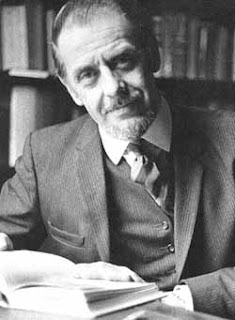From ghostly galloping horse-drawn carriages at Antrim Castle, to rustling silk and eerie knocks at Ballygally Castle, to bumps in the night at the Flax House in Belfast city centre – Co Antrim is our most haunted county.
 |
| Renowned Investigator Peter Underwood |
In his introduction, the 89-year-old said Ireland contains the most varied range of ghosts in the British Isles.
“In England there seems to be a preponderance of white ladies, Scotland has an inclination towards green ladies, but Ireland, with a richness and opulence reminiscent of that green and pleasant land, presents us with a wealth of widely different ghosts and ghostly activity,” he wrote.
“Throughout the length and breadth of the Emerald Isle you will find phantom white, grey and red ladies quite apart from the ghostly nuns, monks, children, soldiers, horses and cats – even a swarm of supernatural fish.
“Here too are phantom boats and horse-drawn coaches, a ghostly hand, a skeleton-like form, a portrait that loses a face once a year, mysterious marks on window panes, a head that rolls across the floor, inexplicable lights and of course the eternal footsteps, the most common of all reported phenomena in haunted houses.”
One of the most haunted properties chronicled in the book is Ballygally Castle close to Larne, now a four-star hotel in the Hastings Group, yet the oldest section has long been home to some much spookier guests.
It was built in around 1615 with five-foot walls, slit windows and original carving, by James Shaw, a descendant of MacDuff, Thane of Fife, whose family was murdered by MacBeth in 834AD, in a tale made famous by playwright William Shakespeare.
Shaw’s wife Lady Isabella died tragically, either murdered or committed suicide after reputedly being ill-treated by her husband. She is thought to have fallen to her death from a castle window. Rustling sounds, as if from a silk dress, have been reported in the ghost room in the castle as well as unexplained footsteps and knocking on doors. There are four executive rooms in the tower which Ballygally Castle Hotel manager Stephen Perry said were much sought-after among guests. He told the News Letter that their guests really enjoyed hearing about the ghost story.
“There would be ones that come to the hotel and they know about the ghost, and there would be ones who don’t and we tell the story and we have literature about the ghost,” he said.
“Some enjoy it, while there are others who are a little perturbed that there may be something passing through their room during the night.
“Any of our guests are welcome to walk through the old original building, up into the ghost room, the dungeon room and the 1625 room which is the original living room/dining room to the old castle.”
Meanwhile, Mr Underwood has singled out Belfast as being “full of ghosts”.
He wrote: “A quick resume includes the ghostly old woman in Annesley Street, two apparitions in the old Smithfield Mill, several ghosts in Raglan Street, the haunting of Belfast old waterworks, the disturbing ghost of Glengyle House, the ghost of ‘old Corby’– and others in the area known as Sandy Row, the ‘bright figure of a girl’ seen in a house in Tomb Street, the ghost of Crumlin Road jail, the haunting of Benn Hospital, Lord Kelvin’s ghost, the York Street ghost, a ghostly figure and strange happenings at the York Road railway depot and many, many more.”
While south of the border, every Twelfth of July, the sound of marching men, galloping horses and the rumble of cannon fire echoes around the Boyne Valley where King William III famously defeated King James II in 1690.
Mr Underwood is one of the world’s best-known experts and authors on the paranormal. He lectures regularly and has written a string of other books including a series of regional ghost tales including Ghosts of London and Ghosts of Wales, as well as the classic Gazetteer of British Ghosts.
Source: Newsletter






![]()
